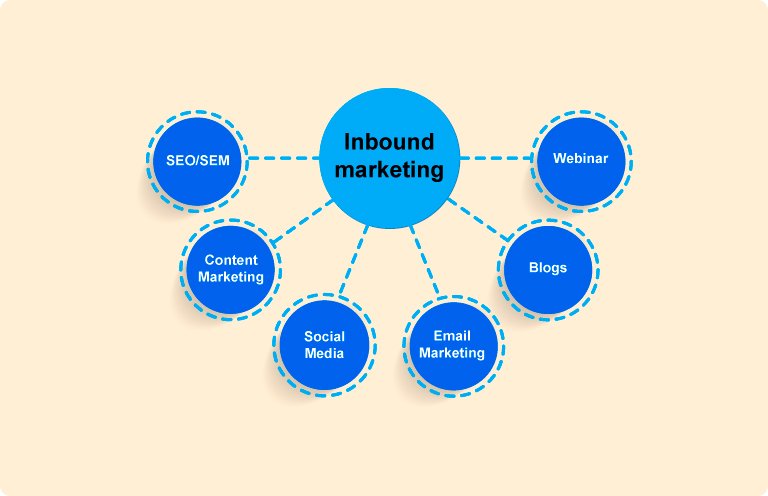Inbound marketing as the core of your marketing strategy

Inbound marketing focuses on a customer’s problem, aware that they need to find a solution to that problem. The goal is to connect with potential customers who are open to that contact. This can be done by making the website an information hub, where quality information on how to solve the problem can be found.

The goal of inbound marketing is to create a website that is the best place on the Internet to find solutions to that one problem. If done properly, it is relatively easy to sell products and services. By focusing on information, inbound marketing helps increase the quality of content on the Internet.
Outbound vs. Inbound marketing
Inbound marketing is a strategy that is being used more and more. It appears to be more effective than longstanding outbound marketing. That form of customer approach involves a lot of promotion through advertisements, hoping to attract interested customers. It is similar to shooting with hail; something always gets hit.
To extend that comparison to the question of “what is inbound marketing”: that’s like shooting with a bullet. A good information strategy creates valuable content with a solution to a well-defined problem. Because customers who have that problem are already looking for solutions, they are more likely to come to your company.
What is inbound marketing
That another form of marketing has emerged is not surprising. Customers, both businesses and consumers, are taking much more control than in the past. They look for solutions to problems on their own, and don’t let themselves be fooled so easily anymore. As a result, the response to an old-fashioned advertising campaign today is less than it used to be.
With an inbound marketing strategy, it is important to be aware of that new behavior. Potential customers are not limited to searching for information through search engines. They also look at competitors’ products and compare customer reviews. The inbound marketing meaning is, companies need to be aware that customers decide what products or services they want to buy, based on their own terms.
Inbound marketing strategy step-by-step
An inbound marketing strategy typically involves four steps. The first step is to analyze the potential customers. That means examining how they self-describe their problem. Based on that knowledge, keywords are determined.

Then content is created, which of course is made SEO friendly. That means the keywords are in the right quantity and in the important places in the content. Site structure also factors into the ease with which search engines rank the website.
The next step is, to start an inbound marketing campaign to promote the content on the website. This serves two purposes. First, relevant websites will post backlinks so that the website will rank higher. By running the campaign widely, including through social media, the first customers quickly become interested.
Conversion of interested visitors
In the first two steps of the inbound marketing strategy, information was offered based on the demand used by interested customers, and the availability of the information was promoted. The next step is to encourage potential customers to request concrete information. This could be a quotation or additional information.
After that, an inbound marketing strategy typically involves helping potential customers make a purchase decision through actions on social media, via email or through personal contact. By measuring the response to these actions, you can find out who is really interested and who is not.
The value of good contacts with customers
Once customers have decided to purchase the product or service, that is not the end of the inbound marketing strategy. In fact, these customers are valuable in convincing subsequent potential customers to purchase the same service or product.

This can be done by having existing customers give a review or recommend your company to their own networks. This in turn gives you better rankings. Also, a good contact with an existing customer provides an opportunity to keep them informed about new products. That provides another opportunity for the next purchase.
Investing in customers
As you’ve seen, in inbound marketing, it takes a lot of energy to create content and sell products and services based on that content. In practice, however, this is much more effective than working with an outbound marketing campaign. When outbound vs. inbound marketing is put there are even more differences to be discovered.
With an inbound marketing campaign, customer satisfaction is higher. They like to stay in touch with the company for any follow-up purchases. This is positive because acquiring new customers is much more difficult than selling something new to existing customers. In outbound marketing, customers usually disappear after one purchase. With inbound marketing, customers remain loyal to the company for years.
Positive effect on Internet quality
The inbound marketing significance for the Internet is great. On the one hand, the quality of information on all kinds of websites becomes much better in level. It also uses SEO more effectively. In addition, search engine quality is increasing.
As a result, many more searches find a ready-made answer. As a result, it takes less time to get a question answered correctly. Moreover, the quality improvement is for the long term. After all, content stays on the Internet for years, so customers can also use it for years.
My advice
Hopefully the question “what is inbound marketing?” has been answered sufficiently clearly in this blog. If you want to get started with an inbound marketing strategy, there are plenty of companies willing to help you do so. Just ask the right question on the Internet, and experience the inbound marketing meaning as a customer.






